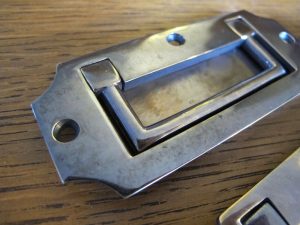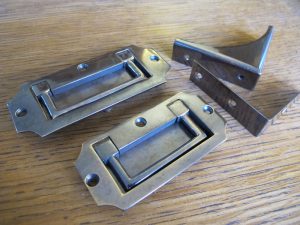We may receive a commission when you use our affiliate links. However, this does not impact our recommendations.
One of the hardware vendors that is always on my short list is Whitechapel Ltd., which offers a lot of quality, hard-to-find pieces. So after some digging through the company’s catalog and web site, I purchased some samples of campaign-style hardware to take a look.
Overall, these English-made brasses are excellent. The pulls are heavy and well-finished. The brackets and corners are scaled correctly and countersunk for screws. I wasn’t, however, thrilled by the coating on the pieces.

I ordered all the parts in Whitechapel’s “antiqued brass” finish; all the following parts are also available in polished brass. While the pieces are toned nicely, the top coating has an iridescence that doesn’t look quite right to me. The coating is very shiny and seems to lend a slight blue cast to the pulls when light reflects off them.
My guess is that they are covered in lacquer, and my first instinct is to dunk them in lacquer thinner and see what they look like after that. But I’m out of lacquer thinner today; I’ll pick some up today and update this blog entry later.
Update: No amount of soaking in lacquer thinner changed the finish. Note the comment below.
Aside from the finish, I am very pleased with these brasses. The flush pulls are made in an unusual way that is worth noting. Instead of casting the backplate as one piece, the manufacturer (Armacuk) made the backplate in two pieces – a cast front and a brass plate for the back. The two pieces are screwed together from the back. It makes for a very tidy piece of hardware.
Whitechapel offers a variety of styles and sizes; see this page for a sample. I ordered a medium pull and a large one.
The corners both have the same finish on them. The decorative corner has a cove shape, which is a common profile on campaign hardware. And the matching corner bracket has the countersunk screw holes right where I’d put them. All the hardware includes nice slotted brass screws.
— Christopher Schwarz
Here are some supplies and tools we find essential in our everyday work around the shop. We may receive a commission from sales referred by our links; however, we have carefully selected these products for their usefulness and quality.












Killer hardware. I bet they would look good on a campaign-style TV console. Hmmm…teak or mahogany?
About 1995 I was updating the 1950’s built house I lived in. I kept the hollow core, birch veneer doors – they looked nice. The doorknobs were all the same – polished brass coated with lacquer. Due to age the lacquer had chipped in many places and the exposed brass tarnished. Overall they looked a bit crummy. Since I liked the shape of the knobs and appreciated the potential of pure brass, and since I am also a bit on the thrifty side I decided to experiment with polishing all these knobs. I mounted a buffing wheel on my bench grinder, bought different grits of rouge and went at it. When I was done I waxed them all with leftover car wax.
Fifteen years later those knobs have “oxidized” in an antique sort of way and look “ok.” If I want to restore the shine it would be a lot of work and I don’t live there anyway. I like the appearance better than the old chipped lacquer.
The “oxidized” finish mentioned in previous post seems like a controlled way to age the parts and stabilize their appearance. I like the idea. It has staying power. If you like the appearance it may mean less work for you in the future. It won’t have the eye-candy appeal of the lacquered hardware or freshly polished brass.
I started buying box locks from Whitechapel Ltd. last year.
I doubt I will buy from any other retailer in the near or distant future. It is amazing how much more easy it is to install a quality-made lock from England than a poorly-made one from China.
They are a very attentive company, as well. After my first purchase from them, I received an e-mail asking how my purchase experience was through their website. I offered a few bits on some problems I saw (minor stuff, like some images that wouldn’t load properly and an image overlapping some text on another page.
When I returned to the website two days later, all of the problems I’d mentioned had been corrected.
According to their catalog the finish is controlled oxidation with no lacquer or other finish. That is for pieces marked code 1
Do you mortise to a depth just deeper than the screws? Does it matter if there is extra air space behind the back plate as long as the three screws and face plate are seated nicely?